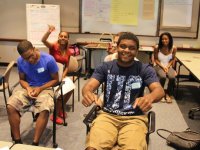Upstander Schools: What’s “Othering” Got to Do With It?
Learn seven ways to build a culture of respect and forgiveness in your school by developing an upstander culture to eliminate the behavior of “othering.”
One of the most effective ways to overcome othering is by making it socially unacceptable. How? By cultivating upstanders among students and adults. Upstanders interrupt biased speech and harmful behavior, and seize the moment to explain why they are offensive. In a recent workshop with high school students, I asked, "How can you make upstanding cool?" Their responses were impressive and in essence called for the creation of a social movement.
What Is Othering?
From a trickle to a steady stream, students are coming out of the shadows to tell stories of repeated shaming, isolation, and abuse at school. They suffer in response to othering, a human behavior that divides people into "us and them" by singling out some for aggression once they are branded as the despised "other." Name-calling, excluding, and incessant lies set the stage for more destructive behavior. It happens to individuals and groups, and changes from one school to the next. The common denominator is cruel speech and actions.
Without othering, thousands of children in American schools would feel safer and more able to focus on learning. Students report being targeted for their differences and for belonging to a cultural, religious, or racial group that is discriminated against. Many who are spared the toxicity of othering still experience anxiety because they don't know how to stop it. It's clear that far too many U.S. students feel humiliated, stressed, and vulnerable as they approach and enter the school building.
The great majority of students in U.S. schools want their classrooms, lunchrooms, hallways, and athletic fields to be safer, and their peers and the adults in the building to be more caring, supportive, and accepting. "No more judging" and "Stop the name-calling" are common refrains. Students want a school environment free of the aggression. They also want to know what to do when adults reveal their own bias and prejudice.
7 Ways to Promote Upstander Culture
For the past five years, I have taught secondary teachers and school counselors about colonialism and genocide to deepen their understanding of those themes, and to explore the connection between genocide in a faraway place (Rwanda) and othering in our schools so they can promote upstander behavior. Here are some ideas to consider if you want to prevent and stop othering, and cultivate upstanders.
1.Values-Based Classrooms
Distressed by the thinning of the curriculum and flood of unwanted requirements, many teachers yearn to create values-based classrooms. Recently tenth and eleventh graders in a Connecticut high school developed a values list. They and their teacher are now trying to share responsibility for upholding it. It's worthwhile to take the time for making sure that everyone understands the meaning behind all words. In one school, we had a rich conversation about "loyalty," and students opted to keep it off their list until further study.
2. Teach Content to Build Character
Teaching about genocide supports character education and helps students reconsider their own assumptions about in-group/out-group dynamics, scapegoating, revenge, and forgiveness. Studying genocide places one's personal challenges in a larger context and supports perspective-taking and the development of empathy.
3. Empower Students Through Circle Process
Indigenous elders from the Pacific Northwest shared this ancient form of social technology with my mentors. Circles are equalizers and constitute an invitation to sit together in respect and confidentiality. When in circle, we listen without judgment, refrain from interrupting, hear all voices, share airtime, learn patience, and speak from our own experiences. A talking piece regulates the conversation. Once students develop comfort with this practice, they call their own circles when relationships are damaged.
4. Cultural Humility
Cultural humility prioritizes self-humility rather than accumulating knowledge about someone else. It presumes becoming open to the other, rather than seeing the other as the object of study.
5. Reaching Out to Adult Peers
Adults must be held to the same standards as students. This is at the heart of the shift toward an upstander culture. To make upstanding the new normal, we need new patterns:
- Hurtful speech is interrupted.
- Those responsible are engaged in conversation to make sure they know that what they said is hurtful.
- Offer them a way out so that they'll reconsider.
- Reinforce positive behavior.
- Encourage others to speak up -- a key lesson from studying genocide is that bystanders enable it.
6. Meditation / Brain Breaks / Quiet Time
Whatever you call it, there is growing evidence that students and teachers benefit from making time to quiet the mind and reduce stress in the classroom. Meditation teaches self-control, lessens the grip of the impulsive side of our brains, lowers stress-related cortisol levels, and strengthens the functioning of the pre-frontal cortex. It is like giving food to the brain without going to the lunchroom.
7. Rehumanize the Offenders
One of the things we learn by studying genocide is that the rehumanization of perpetrators is important to the long-term success of personal and social healing. Those who offend often have their own stories of mistreatment and abuse. If you want to spread empathy in your classroom, don't leave out those who hurt others. Eventually they might become the most powerful and effective messengers of compassion and caring.
How do you build a culture of respect and forgiveness in your classroom? Please tell us about it below in the comment section.
